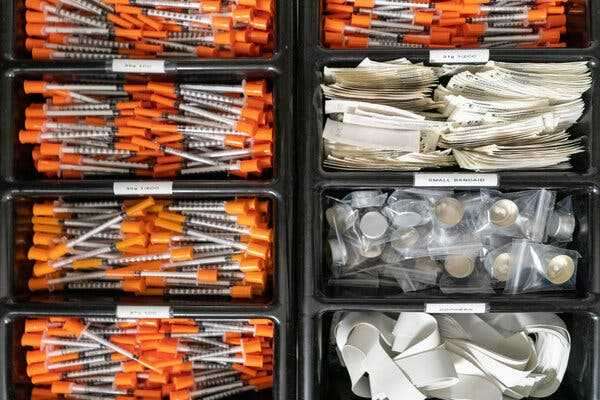President Biden has made “harm reduction” a central pillar of his plan to fight a record number of drug-related deaths, but a conservative backlash is threatening the effort.

Narcotic consumption material at a safe injection site in New York.
WASHINGTON — President Biden came into office vowing to make “harm reduction” — a public health approach geared toward helping drug users stay safe rather than abstain — a central pillar of his drug policy agenda, at a time when illicit fentanyl has driven a surge in overdose deaths.
Instead, his strategy is in danger of being derailed by a Washington drama over “crack pipes” that is more about political gamesmanship than public health. The clash is a revival of decades-old fights over clean needle exchange programs that addiction experts hoped had finally been laid to rest.
Lawmakers of both parties introduced legislation last week to bar federal funding for “drug paraphernalia” in response to a story in the Washington Free Beacon, a conservative website, asserting that federally funded addiction treatment programs would distribute pipes for smoking crack cocaine as part of “safe smoking kits.” In response, the White House said tax dollars would not be spent on pipes.
But with the Beacon story ricocheting around the conservative ecosystem — amplified by Republican including Senators Tom Cotton of Arkansas and Ted Cruz of Texas — Congress is pursuing plans not only to bar federal funding for “crack pipes,” but to impose restrictions on a new program that would have, for the first time, allowed federal funds to be spent on sterile needles for “syringe services” programs.
Multiple studies have shown that distributing new syringes to drug users reduces the spread of blood borne diseases among drug users, including H.I.V., hepatitis C and lethal heart infections. The programs also provide naloxone, the overdose-reversing drug, and connect drug users to treatment and other resources.
Some harm reduction programs do include sterile pipes — which are used for smoking methamphetamine and fentanyl as well as crack cocaine — in such kits, with the intent of preventing infectious disease or injury in drug users who might otherwise rely on contaminated paraphernalia. Harm reduction workers often try to steer users toward smoking rather than injecting, which poses a higher risk of infection and overdose.
But there is no evidence that the Biden administration intended to pay for distribution of pipes. Nonpartisan fact checkers have debunked the claim.
“This is tragic — we’ve gone full circle,” said Donna E. Shalala, who fought — and lost — a battle to get federal funding for needle exchange programs in the 1990s, when she was President Bill Clinton’s health secretary. Harm reduction, she added, “is a respectable, important strategy.”
Yet even now, decades into a pervasive opioid epidemic that has led to hundreds of thousands of overdose deaths from prescription painkillers, heroin and synthetic fentanyl, which now also frequently turns up in stimulants like methamphetamine and cocaine — and many more from infectious diseases stemming from drug use — addiction experts say the backlash is not entirely surprising.
As Regina LaBelle, an addiction policy expert at Georgetown University and the architect of Mr. Biden’s harm reduction policy, said in an interview: “We knew it wasn’t going to be easy.”
Roughly 100,000 Americans died last year from drug overdoses, according to preliminary data from the Centers for Disease Control and Prevention — a record number that has more than doubled since 2015.
ImageEmergency personnel responded to a call in 2020 for a drug overdose in Paterson, N.J.Credit…Chang W. Lee/The New York Times
The crack pipe fracas arrived just as experts thought they were making progress in getting politicians, including conservative Republicans, to accept harm reduction as a valid strategy. A case in point is former Vice President Mike Pence.
In 2015, when Mr. Pence was the governor of Indiana, H.I.V. was spreading with terrifying speed among intravenous drug users in Scott County, a rural pocket of the state. Local, state and federal health officials were urging Mr. Pence to allow clean needles to be distributed to slow the outbreak, but Indiana law made it illegal to possess a syringe without a prescription.
Mr. Pence, a steadfast conservative, was morally opposed to syringe exchanges on the grounds that they enabled drug abuse. But when the county sheriff urged him to allow the programs, Mr. Pence prayed about it — then signed an executive order doing so. It helped slow the H.I.V. outbreak to a trickle.
Nearly two decades earlier, in 1998, Mr. Clinton blocked federal funding for clean needle programs, despite a personal appeal from Ms. Shalala. In an interview, she said Mr. Clinton had buckled under pressure from Democrats in Congress, who worried they would lose elections by being portrayed as soft on crime.
Undeterred, Ms. Shalala encouraged philanthropies to finance needle exchange programs, and instructed National Institutes of Health experts to conduct trainings on needle exchange. Mr. Clinton later said he regretted his decision.
When Mr. Biden was elected, addiction experts were elated. The American Rescue Plan, the coronavirus relief package he signed into law last year, set aside $30 million for a new Harm Reduction Grant Program to “support community-based overdose prevention programs, syringe services programs, and other harm reduction services.”
It was the first time Congress had created a specific grant for harm reduction programs — which often run on shoestring budgets — and the grant program was exempt from a longstanding ban, renewed annually in spending measures, on using tax dollars to purchase clean needles. Some experts thought the ban might be lifted for good.
“We finally got to a place where that ban was going to be lifted, we would see sustainability, we would see a massive shift in our current state of infectious disease,” said Chad Sabora, vice president of government and public relations at the Indiana Center for Recovery, a treatment center. He called the new controversy “heartbreaking.”
Safe smoking kits are often distributed by syringe service programs, and often include glass stems, which function as pipes, as well as lip balm, alcohol swabs, rubber tips and other items to protect against mouth sores and cuts that can spread disease. The guidelines for the new federal grant program are not specific about it about whether the kits can include pipes.
The law is murky; a 1986 law classifies crack pipes (but not needles) as drug paraphernalia and makes it illegal to sell or ship them. Ms. LaBelle said that law, and similar state laws, arguably could preclude the government from funding the glass stems that serve as pipes.
After the uproar over the Free Beacon article, the White House Press Secretary, Jen Psaki, said glass pipes were “never a part of the kit,” insisting the story was untrue.
Conservatives accused the White House of reversing itself.
“The Biden administration is in cleanup mode because they got caught funding crack pipe distribution,” Mr. Cotton wrote on Twitter.
Many addiction experts saw the political blowup over crack pipes as having racist undertones. Dahlia Heller, an addiction policy expert at Vital Strategies, a global nonprofit organization that supports harm reduction, said the Beacon story was “calling up a racist trope, very clearly, of Black people smoking crack. It was dog whistling a 1980s war on drugs.”
Mr. Cotton, who leads a bipartisan commission to combat the trafficking of synthetic opioids — particularly fentanyl — was among those who responded by introducing legislation to ban funding for drug paraphernalia. Yet even as he expressed his outrage over crack pipes, he issued a commission report citing needle exchange programs as a well-documented way to get people struggling with drug abuse into treatment.
ImageDrug treatment programs funded by the federal government also include the use of naloxone, or Narcan, which can save drug users who overdose.Credit…Whitney Curtis for The New York Times
Mr. Cotton’s spokeswoman, Caroline Tabler, said the commission did not suggest expanding needle exchange programs. Mr. Cotton opposes syringe services programs, which he believes “would enable drug use, empower drug suppliers, and harm Americans,” she said.
Mr. Cotton is not the only lawmaker parsing his words. Senator Joe Manchin III, Democrat of West Virginia, reacted to the Beacon story by joining with Senator Marco Rubio, Republican of Florida, to introduce the PIPES Act, which would bar federal funds from being used to purchase “drug paraphernalia, such as crack pipes or needles.” The initials stand for Preventing Illicit Paraphernalia for Exchange Systems.
Mr. Manchin’s home state is West Virginia, a longtime epicenter of the opioid crisis. The state capital, Charleston shuttered its harm reduction program in 2018; by the end of the year Charleston was leading the state in overdose deaths. West Virginia is among a number of states that have recently passed laws making it more difficult for syringe services to operate, as state lawmakers continue to oppose them on the grounds that they enable drug use and draw community complaints.
“Manchin was never going to save us, but now it looks like he is going to bury us,” said Joe Solomon, a founder of Solutions Oriented Addiction Response, or SOAR, a which ran a syringe exchange program in Charleston until last year, when the City Council imposed restrictions that effectively forced its closure.
Yet in 2016, Mr. Manchin praised President Barack Obama for an initiative that included needle exchange programs. That program was the result of a compromise: after nearly 30 years of an outright ban on any funding for needle exchange programs, Congress agreed to pay for program operations — but not the needles themselves — so long as state and local authorities, in consultation with the C.D.C., determined that a community was in danger of an infectious disease outbreak.
The Manchin-Rubio bill would retain the current language about the C.D.C., but would extend the ban on purchasing needles to the American Rescue Plan funding. Its fate, and the fate of bills like it, is uncertain. Mr. Rubio tried unsuccessfully to force senators to vote on the measure before passing a spending resolution last week, and Congress is now on recess until the end of the month.
In the meantime, Ms. LaBelle said, she and other experts have some work to do.
“We have a lot of ingrained ideas about substance use and people are working hard to make sure that the general public understands what addiction is, what a substance use disorder is — that it’s not a moral failing,” she said. “But we’re still not at that point.”
Source: nytimes.com



